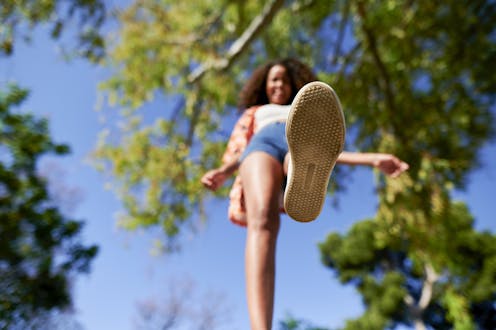Do you crush microbes when you step on them?
- Written by Ashok Prasad, Associate Professor of Chemical and Biological Engineering, Colorado State University

Stepping on a microbe
Now what happens to a bacterial cell when you apply the force of your footstep on it?
Bacteria have different shapes[10], ranging from spheres to rods and spirals. Bacterial cells have walls that protect their gel-like insides from the environment. How strong is a bacterial cell wall, and can it withstand the force of your footstep?
Scientists have studied the strength of bacterial cell walls for several reasons, including to find out whether high pressure can kill bacteria[11]. People in the food industry use high pressure[12] to make food such as milk safe for us to consume.
To determine the toughness of bacterial cell walls, researchers use a variety of tools to measure their ultimate tensile strength[13], which is the maximum pressure an object can withstand before breaking. This can be done, for example, by putting them in a sealed container and rapidly lowering the pressure until they explode. A 1985 study found that it would take nearly 1,500 pounds per square inch[14] to make the bacterium Salmonella explode, and later experiments showed it would take about 1,900 pounds per square inch[15] for the common soil bacterium Bacillus subtilis to explode. That’s 400 to 500 times more pressure than your sneaker is going to have on the sidewalk and any microbes lying about.
To understand these numbers in a different way, imagine a bacterium large enough for a person to stand on top of it. If it had the same cell wall strength as Salmonella, it could support over 350 people of 110 pounds each standing on it at the same time. While high pressures can kill bacteria in some applications such as food processing[16], one person standing on them won’t work.
Slipping through the cracks
It’s clear that bacterial cell walls are very strong. But there’s an added complication that makes it even harder to squish bacteria: They’re incredibly small. The average bacterium is only about 1 to 5 microns or millionths of a meter[17] (smaller than ten-thousandth of an inch) in size. In comparison, the tip of a common pin is about 130 microns in diameter.
The surface of your skin has fine grooves called sulci cutis[19] that are, on average, tens of microns deep. The soles of your shoes also have grooves that are much deeper than the ones in your skin. As a result, whether you are stepping on bacteria with your bare feet or while wearing shoes, most of the cells will slide into one of those grooves and escape from the full pressure you exert on the ground.
Standing on a pin
How could you increase the pressure your feet exert on a bacteria cell to squish it?
One theoretical way would be to change the bottoms of your shoes from flat to very pointy, with the bottom of the point having a diameter as wide as the tip of a pin. While walking on these shoes would be impossible, a 110-pound person would exert a pressure of 5.6 million pounds per square inch. That is enough to smash any known bacteria.
While people can’t actually do this, it turns out that some insects can. Cicada wings have tiny molecular structures[20] that look like needles. These needle-like structures are only nanometers in size, a thousand times smaller than most bacteria, and are called nanorods.
Cicada wings are covered with cone-shaped nanopillars that can puncture bacteria.When a bacterium lands on the surface of the cicada wing, it makes special chemicals that help it stick to the surface. When the bacteria divides, it produces tiny forces that allow the new cells to separate from each other. These small forces are magnified into enormous pressures when they push against the nanorods on the cicada wing, puncturing the bacteria and killing it.
Cicadas, dragonflies and many other flying insects have similar wing surfaces that are naturally bactericidal, meaning bacteria killing. Bioengineers are taking inspiration from nature and trying to make surfaces with needle-like structures that kill bacteria in a similar way[21].
Hello, curious kids! Do you have a question you’d like an expert to answer? Ask an adult to send your question to CuriousKidsUS@theconversation.com[22]. Please tell us your name, age and the city where you live.
And since curiosity has no age limit – adults, let us know what you’re wondering, too. We won’t be able to answer every question, but we will do our best.
References
- ^ Curious Kids (theconversation.com)
- ^ curiouskidsus@theconversation.com (theconversation.com)
- ^ studies mechanical forces in biology (scholar.google.co.in)
- ^ genetically engineers microorganisms (scholar.google.com)
- ^ exert a force (eng.libretexts.org)
- ^ area over which that force is distributed (eng.libretexts.org)
- ^ atmospheric pressure (www.britannica.com)
- ^ NIAID/Flickr (flic.kr)
- ^ CC BY (creativecommons.org)
- ^ have different shapes (microbiologysociety.org)
- ^ high pressure can kill bacteria (bio.libretexts.org)
- ^ food industry use high pressure (education.seattlepi.com)
- ^ ultimate tensile strength (chem.libretexts.org)
- ^ nearly 1,500 pounds per square inch (doi.org)
- ^ about 1,900 pounds per square inch (doi.org)
- ^ food processing (doi.org)
- ^ 1 to 5 microns or millionths of a meter (book.bionumbers.org)
- ^ deyangeorgiev/iStock via Getty Images Plus (www.gettyimages.com)
- ^ sulci cutis (doi.org)
- ^ tiny molecular structures (doi.org)
- ^ kill bacteria in a similar way (doi.org)
- ^ CuriousKidsUS@theconversation.com (theconversation.com)
Authors: Ashok Prasad, Associate Professor of Chemical and Biological Engineering, Colorado State University
Read more https://theconversation.com/do-you-crush-microbes-when-you-step-on-them-199074

